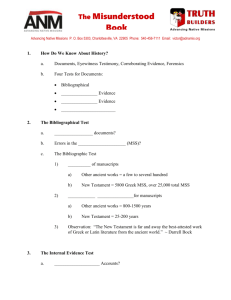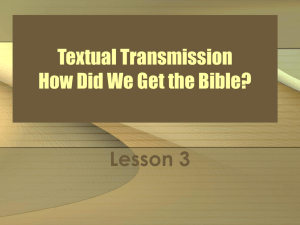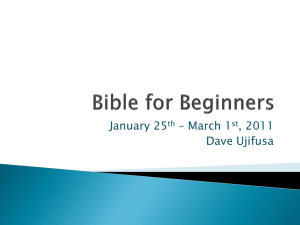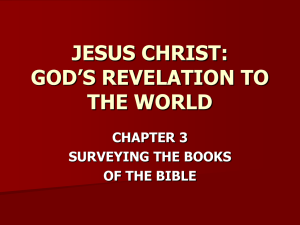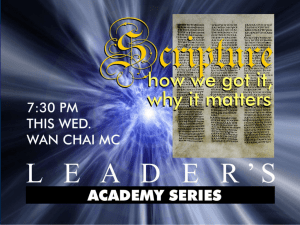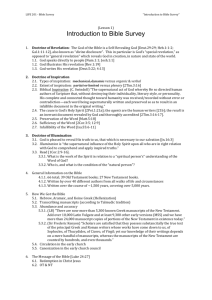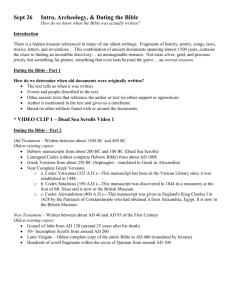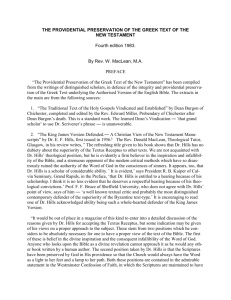File
advertisement
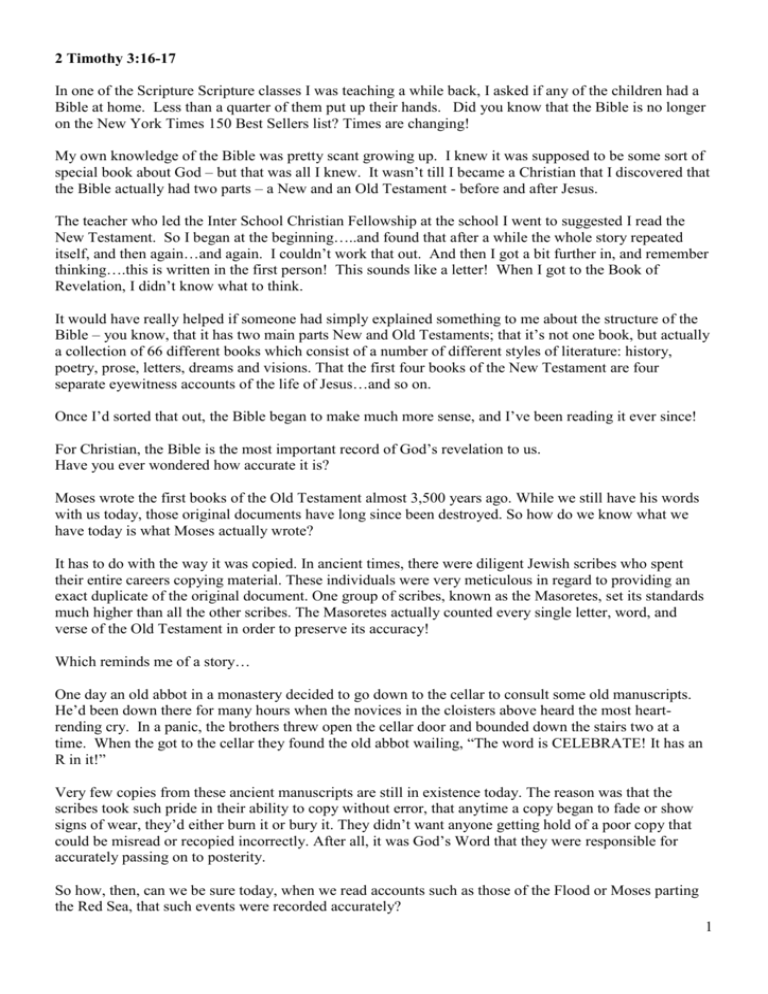
2 Timothy 3:16-17 In one of the Scripture Scripture classes I was teaching a while back, I asked if any of the children had a Bible at home. Less than a quarter of them put up their hands. Did you know that the Bible is no longer on the New York Times 150 Best Sellers list? Times are changing! My own knowledge of the Bible was pretty scant growing up. I knew it was supposed to be some sort of special book about God – but that was all I knew. It wasn’t till I became a Christian that I discovered that the Bible actually had two parts – a New and an Old Testament - before and after Jesus. The teacher who led the Inter School Christian Fellowship at the school I went to suggested I read the New Testament. So I began at the beginning…..and found that after a while the whole story repeated itself, and then again…and again. I couldn’t work that out. And then I got a bit further in, and remember thinking….this is written in the first person! This sounds like a letter! When I got to the Book of Revelation, I didn’t know what to think. It would have really helped if someone had simply explained something to me about the structure of the Bible – you know, that it has two main parts New and Old Testaments; that it’s not one book, but actually a collection of 66 different books which consist of a number of different styles of literature: history, poetry, prose, letters, dreams and visions. That the first four books of the New Testament are four separate eyewitness accounts of the life of Jesus…and so on. Once I’d sorted that out, the Bible began to make much more sense, and I’ve been reading it ever since! For Christian, the Bible is the most important record of God’s revelation to us. Have you ever wondered how accurate it is? Moses wrote the first books of the Old Testament almost 3,500 years ago. While we still have his words with us today, those original documents have long since been destroyed. So how do we know what we have today is what Moses actually wrote? It has to do with the way it was copied. In ancient times, there were diligent Jewish scribes who spent their entire careers copying material. These individuals were very meticulous in regard to providing an exact duplicate of the original document. One group of scribes, known as the Masoretes, set its standards much higher than all the other scribes. The Masoretes actually counted every single letter, word, and verse of the Old Testament in order to preserve its accuracy! Which reminds me of a story… One day an old abbot in a monastery decided to go down to the cellar to consult some old manuscripts. He’d been down there for many hours when the novices in the cloisters above heard the most heartrending cry. In a panic, the brothers threw open the cellar door and bounded down the stairs two at a time. When the got to the cellar they found the old abbot wailing, “The word is CELEBRATE! It has an R in it!” Very few copies from these ancient manuscripts are still in existence today. The reason was that the scribes took such pride in their ability to copy without error, that anytime a copy began to fade or show signs of wear, they’d either burn it or bury it. They didn’t want anyone getting hold of a poor copy that could be misread or recopied incorrectly. After all, it was God’s Word that they were responsible for accurately passing on to posterity. So how, then, can we be sure today, when we read accounts such as those of the Flood or Moses parting the Red Sea, that such events were recorded accurately? 1 One very strong piece of evidence is the Dead Sea Scrolls. In 1948, an Arab boy was looking for his lost goat. As children do, this lad entertained himself by throwing rocks as he walked. He threw one of those rocks into a small cave, and heard the sound of pottery breaking. Venturing into the cave, he found some leather scrolls with ancient writing on them. Inside the cave were hundreds of scrolls, most likely written by a group of people known as the Essenes. Among the important discoveries from the caves were copies of several books of the Old Testament. These copies were almost 900 years older than the oldest available copies of Old Testament books. One scroll found in the Dead Sea caves was of particular importance. It was a scroll of the book of Isaiah—from which only a few words were missing! What was amazing about this scroll was that, when it was compared to the text of Isaiah produced 900 years after it, the two matched almost word for word! So, we can be confident that the Old Testament we hold in our hands today is worded exactly as the original writers wrote it. What about the New Testament? How can we feel confident that Bibles being printed in 2013 still contain the words that God inspired nearly 2,000 years ago? Various parts of the New Testament were written between approximately A.D. 35 and A.D. 100. We know that among the books in the New Testament are letters that were sent to various churches from the apostle Paul. Those letters were priceless to those who received them. Because of that, copies sometimes were made. Unlike the scribes who copied the Old Testament, people who copied the New Testament books did not see the need to bury or burn old, worn-out copies of the Scriptures. As a result, we still possess literally thousands of manuscripts of the New Testament Since the New Testament originally was produced in Greek, the manuscripts also are written in Greek. Over 5,700 old manuscripts exist of various portions of the New Testament. The total number of manuscripts is amazing, especially when compared to other ancient books. For example, Homer’s Iliad is one of the most famous ancient books in history. But there are less than 700 ancient copies of his book in existence. Another factor that supports the accuracy of the New Testament is that the manuscripts were produced mere decades after the apostles died. The earliest copy dates back to A.D. 130. The most accurate copy of a secular historical document we have was dated 900 years after the event! Far more than being the most accurately preserved ancient historical document, the Bible is given to us by God himself. It is inspired by him Listen to these two verses from 2 Timothy: “All Scripture is inspired by God and profitable for teaching, for reproof, for correction, for training in righteousness; so that the man of God may be adequate, equipped for every good work.” When Paul says “All Scripture” he is actually only talking about the books from Genesis to Malachi – what we know as the Old Testament. But as the Apostles writings were copied and circulated, the church came to realise their value and their writings were also included in the Canon of Scripture. (We might look at how the Canon came in to being another time). What does “inspired by God” mean? 2 It doesn’t mean that God tapped say Moses on the shoulder, and dictated the text to him. It does mean that through the Holy Spirit, God revealed to certain people who he was and what he planned to do. These writers then recorded the message for God’s people. In this process, God used the writer’s own personal, historical and cultural contexts as a tool to convey his message. He used their gifts and their personalities. The writings have the stamp of the writer, but are nonetheless inspired by God. The verse goes on to say that The Scriptures are profitable for teaching, for reproof, for correction, for training in righteousness; so that everyone who belongs to God may be proficient, equipped for every good work. The Bible is the source of our knowledge of God; it is the foundation of our personal relationship with him, and it tells us of our duty towards him, towards our brothers and sisters in Christ, and towards the world around us. The Bible is our safeguard against false teaching and our source of guidance for how we should live. It is our only source of knowledge about how we can be put right with God. Through its wisdom, God equips us to be his servants and to carry on his work in this world. So…it stands to reason that if God went to all this trouble to inspire, create and preserve this incredible book – we should READ it. Regularly! One of the wonderful traditions that has come to us through the evangelical church is the regular “Quiet Time.” It means a daily time set aside to spend time with God; to read and meditate on the Scriptures and to pray. For many of us, it is a well-established discipline in our lives. It was one of the first things my mentor trained me to do when I first became a Christian. And I’m very grateful to her for that. She put me on to little books called “Daily Bread”. You’ve heard of them? I’m sure many of you have used or still use them. They give a passage of scripture, a short explanatory comment which helps you understand the passage and apply it to your life, and then a suggestion for prayer. There are many, many aids to Bible reading available now – far more than there were in my “Daily Bread” days. “Every Day With Jesus” is another one, which became my personal favourite for many years. If we are serious about living for God, we CANNOT do it without the teaching, correction, guidance and encouragement of his Word. Sermons at church are helpful, but there are so many other ways to be nourished by God’s word. We can read and study it alone, we can study it in a group, we can listen to recordings or read books. But the most important thing of all- is to actually READ it. May I leave us with a challenge today? If reading the Bible hasn’t had much of a place in our life; or if we’ve let it slip; or if we’ve let it get stale - let’s determine as we walk out the door to CHANGE the situation, and to allow God to transform us through his Word. Let’s pray. 3

